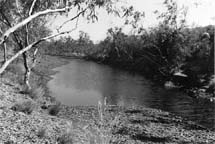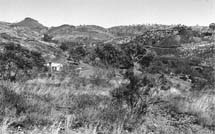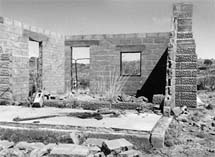Back in them days
Michael Hester is a man who has had a
lifelong
passion for history. He has been active in the National Trust
for most of his 20 years in Tennant Creek
For 13 years he took people bush on his Mulga Track Tours.
Here he recounts the history behind Hatches Creek and
Old Police Station's Waterhole
Hatches Creek first came to notice because
way back in 1898, a hundred years ago, Alan Davidson's Central Australian
Exploration Company was coming through and they were looking for gold
in the Northern Territory. They were passing through Hatches Creek looking
for gold but they didn't find any so they moved on. Some years later
in 1913 the Director of Mines, T.G Oliver, was in Barrow Creek and he
was interested in new mineral discoveries.
They were actually looking for wolfram at this stage, in 1913, because
wolfram is used in the manufacture of ammunition and there was a great
demand for wolfram in both the First and Second World Wars. Wolfram
is an ore and from that they get Tungsten which is a metal used for
hardening the tips of drills among other things.
Oliver was in the Barrow Creek pub and he overheard this fellow talking,
saying that he knew where there was some wolfram because he'd been in
Hatches Creek way back in 1898 and he'd noticed this stuff which Davidson's
party weren't interested in because they were looking for gold.
He said, "I know where there's some wolfram", so Oliver arranged
to grub stake this fellow; in those days you could get assistance from
the government to help you with new mineral discoveries.
He got his supplies together to the value of fifty pounds and pack horsed
into Hatches Creek and sure enough it was wolfram that they'd found.
That was in 1913 when the first leases were taken up and it became a
pretty important little centre. It wasn't just one mine, it was a whole
lot of little mines at Hatches Creek.
It wasn't a big mining company that went in there and started digging,
big mining companies didn't exist in those days. Places like Hatches
Creek started with just small parties, always more than one though because
you could never go mining on your own. You always had to have a mate
because you'd be down the shaft and he'd be at the top. You couldn't
do it on your own.
It was those sort of small shows like that all through the next few
years. It never really grew into a large settlement, there were always
a lot of mines but not a great number of miners because some miners
would go there, they wouldn't be very successful so they'd move on.
The fact that it was very, very remote meant it took days to get there
from Alice Springs with a horse and dray. Motor transport was around
by then but mostly it was still a job for pack horses and camels.
After World War I, as the demand for wolfram declined, so did Hatches
Creek. There was a big surge again before World War II and by that time
of course, Tennant Creek had started. When World War II began a lot
of the miners in Tennant Creek went away to the War, but some of the
ones that didn't went down to Hatches Creek because it was more profitable
to mine wolfram than gold at that stage.
During World War II a lot of indentured Chinese labourers were evacuated
from Nauru in the Pacific, where the Japanese were threatening to take
over, which they did eventually.
These indentured labourers were bought to Australia and it was thought,
well they're used to heat and everything and it was cheap labor so they
were sent to Hatches Creek and Wauchope to work there mining wolfram.
There's quite a lot of evidence left behind particularly in Wauchope
of the Chinese workers having been there.
After World War II it got a bit bigger as larger companies started to
come in and take over like they did elsewhere. Like they did in Tennant
Creek.
There was quite a large mine at Hatches Creek called The Pioneer mine
which was worked right up until the 1970s, the headframe is there still.
It would be have been as large a mine as some of the medium sized mines
here. The workings of The Pioneer would have been similar to what Eldorado
was like. Eldorado's Headframe wouldn't have been much bigger than Pioneer's.
It was quite a big show, but once the demand for a mineral goes, so
do the mines.
Hatches Creek wasn't a community that stayed on after the mining had
finished, it was just a mining settlement and it wasn't one of those
mining towns that supported many families either. It was so remote that
it attracted more of the wandering sort of prospector, particularly
in the early years of settlement. There were a few families in later
years, Mrs Marjorie Fulwood who still lives in Tennant Creek, was there
in 1935 with her family. Her children actually went to school in Hatches
Creek for a while.
A couple of years ago a lady wrote to me from South Australia and said
that her husband had been brought up as a child at Hatches Creek. His
father, Lou Bailey had run the store there. Her husband had a terminal
illness and he wanted to go back to Hatches Creek where he had grown
up to re-capture some of his boyhood.
These people came to Tennant Creek and I safaried them out there, because
I was operating my Mulga Track tours then. I took them down there in
my bus and we stayed a week and he took me all over Hatches Creek and
showed me the ruins. There are quite a lot of remains of a brick house
on a bit of a hill with the windows still there and the floors and that
was where his father and family ran the store.
That was fascinating because I learnt more about Hatches Creek in that
week than I did in all the years I'd been going there on my own and
from what I'd read. We took lots of photographs and he was very happy
and we came back to Tennant Creek and they went home to South Australia.
His wife wrote to me a few months later and said that he had lost the
battle with his illness but at the end had been so glad he had made
the journey back to his childhood.
Old Police Station Waterhole:
It's marked on the maps as Old Police Station Waterhole, but a lot of
people just call it Policeman's Waterhole. So if it's got Policeman's
Waterhole on the sign then I'll give up about calling it Old Police
Station Waterhole, what hope have I got!
Old Police Station Waterhole is beautiful, it's about half way between
Hatches Creek and Kunrundi on the Frew River. It's pretty old, it was
established in 1920 which was a long time before Tennant Creek was established.
It was an Outstation for the Police Station and jail at Heavitree Gap
in Alice Springs.
There was only one policeman there and an Aboriginal assistant. But
you couldn't imagine a more remote place than Police Station Waterhole
in 1920. It wasn't on the route to anywhere, it was established more
or less as a stock inspector's Station rather than a Police Station.
The work of the policeman there was to do with stock and attending to
complaints about stock being taken from one property to another and
that sort of stuff.
The head of the Frew river is down south west of Hatches Creek township
where it is joined by Hatches and Mia Mia Creeks, it then branches away
to the north. From the confluence of these creeks to the Old Police
Station Waterhole is about 10 to 15 kms and the river flows through
some of the most beautiful country in the Northern Territory. You could
compare it to Katherine Gorge even! It's not as large or spectacular
as Katherine Gorge because it hasn't got the height, but it's a miniature
Katherine Gorge.
The only way you can travel through this gorge is on your own two feet.
A few of us have done it. I think the last person I spoke to that did
it was Basil Courts. Molly and Basil Courts were Tennant Creek residents
for many years and Basil Courts used to be a Policeman, his last job
was as a Security Guard at Warrego. Basil was one of the last people
who walked through there with Bob Clough of Epenarra Station.
To walk through this gorge, you have to leave a vehicle at the Police
Station Waterhole and then you drive another vehicle to the other end
and you walk through. You can't take a vehicle through, it's just not
possible. It's quite a few kilometres, so it's a fair walk but it's
worth it because the country is so beautiful and the wildlife is amazing.
At certain times of the year it's better than others. You wouldn't be
able to go through there if the river was in full spate for instance
because the water would be roaring through gorges. The best time to
go through is just after the water has subsided, no river in the Central
Australian region flows regularly - not in the sense that the Murray
flows anyway.
Territory rivers flow after heavy rain and then they become a series
of waterholes connected by maybe just a dribble of water and that dribble
soon dries up and then it's just waterholes.
It's now part of the proposed Davenport National Park and part Aboriginal
land. So after all these years I'm not quite sure of the correct procedure
for getting in there.


Simon Rieff was a
prospector, miner and assayer. His house remains to this day. Clifford's
Tower and Treasure Mine are in the background.

Lou Bailey's house
viewed from the east front room.